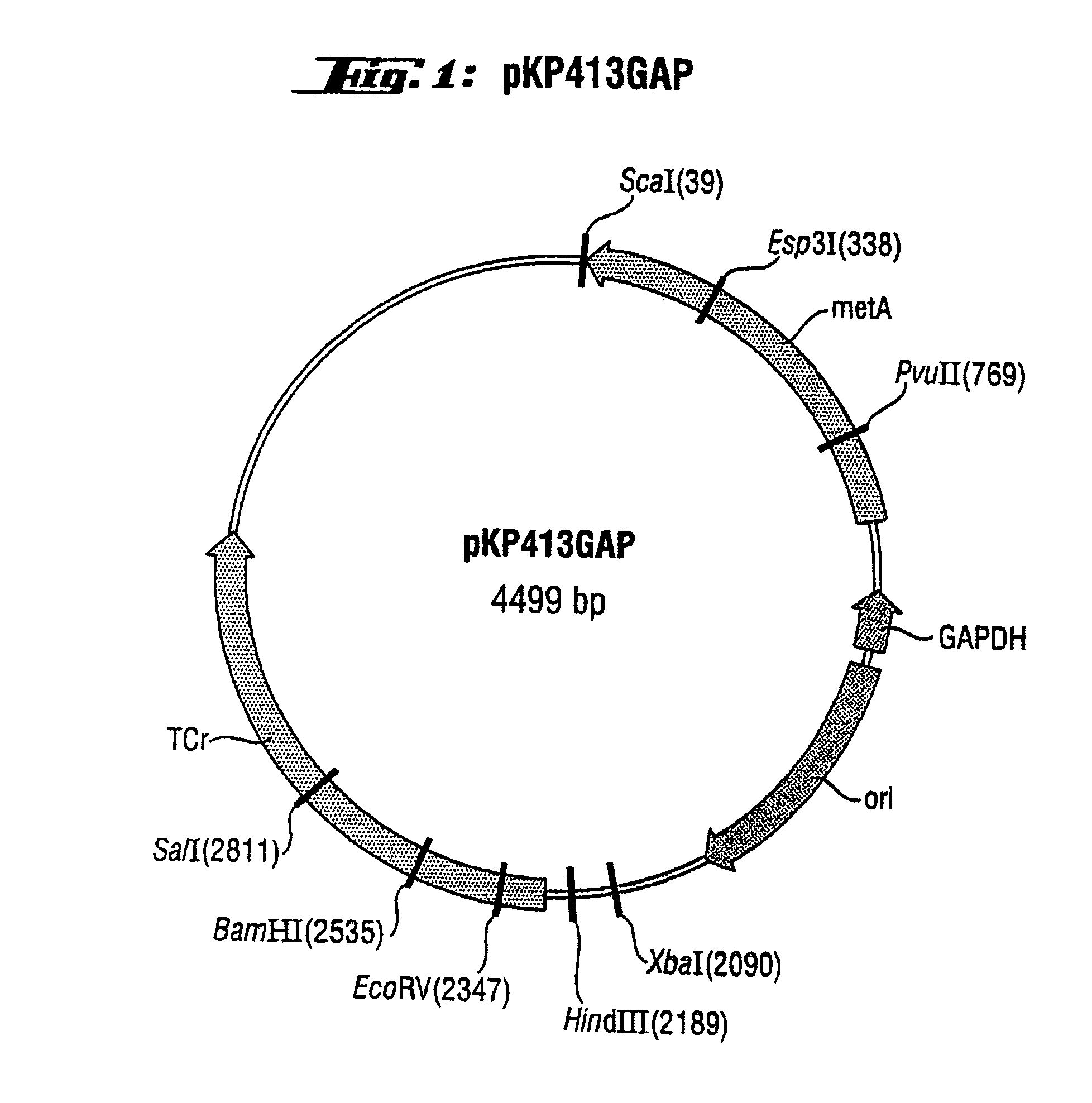Feedback-resistant homoserine transsuccinylases
a technology of homoserine and sucinylase, which is applied in the direction of transferases, enzymology, organic chemistry, etc., can solve the problems of not being able to assign different, not being able to draw conclusions, and not being able to do so
- Summary
- Abstract
- Description
- Claims
- Application Information
AI Technical Summary
Benefits of technology
Problems solved by technology
Method used
Image
Examples
example 1
Using Undirected Mutagenesis of the metA Structural Gene to Generate Feedback-Resistant Homoserine Transsuccinylases
[0042]The E. coli metA gene was amplified by the polymerase chain reaction using the 5′-end-phosphorylated oligonucleotides metAfw, having the sequence
5′-GATCCCATGGCTCCTTTTAGTCATTCTTAT-3′ (SEQ ID No. 3), and metArev, having the sequence
5′-GATCGAGCTCAGTACTATTAATCCAGCGTTGGATTC-3′ (SEQ ID No. 4),
[0043]as primers and chromosomal DNA from E. coli strain W3110 (ATCC 27325) as the substrate. The product, which was 1.1 kb in length, was isolated electrophoretically and purified using a QIAquick gel extraction kit (Qiagen). After that, T4 DNA ligase was used to insert it into plasmid pBR322 (MBI Fermentas) which had been treated with the restriction enzyme EcoRI and the Klenow fragment (Roche). The resulting plasmid, i.e. pKP438, was used for the mutagenesis.
[0044]Plasmid pKP438 was introduced, by means of transformation, into the E. coli strain XL1-Red (Stratagene) and mutatio...
example 2
Using Specific Base Replacements in the metA Structural Gene to Generate Feedback-Resistant Homoserine Transsuccinylases
[0046]metA alleles which encode homoserine transsuccinylases which are feedback-resistant in regard to L-methionine and / or SAM, due to base replacements and accompanying amino acid changes at positions 101 and, respectively, 294 (see Examples 3 and 4) were prepared in Example 1. Site-specific mutagenesis was therefore used to construct genes which encoded homoserine trans-succinylases in which either the amino acid aspartate at position 101 or the amino acid tyrosine at position 294 is replaced with a variety of other amino acids and which, as a result, exhibit altered properties with regard to the inhibition of their activity by L-methionine and SAM.
[0047]The plasmid pACYC184-LH, which is derived from pACYC184 and which is deposited in the Deutsche Sammlung für Mikroorganismen und Zellkulturen [German collection of microorganisms and cell cultures] in Brunswick un...
example 3
Activity of the Homoserine Transsuccinylase Mutants, and Feedback Resistance in Regard to L-Methionine
[0057]The activity, and the influence of L-methionine on the activity, of the different homoserine transsuccinylases were determined by means of an enzyme test using cell extracts in which the respective proteins had been produced. For this, the corresponding plasmids, encoding altered homoserine transsuccinylases, were introduced, by transformation, into the E. coli strain W3110 (ATCC 27325) using methods known to the skilled person. The transformation mixture was spread on LB-tetracycline agar plates (10 g of tryptone / l, 5 g of yeast extract / l, 5 g of NaCl / l, 15 g of agar / l and 15 mg of tetracycline / l) and incubated at 37° C. overnight. The resulting transformants were grown in SM1 medium (for 1 l of medium: CaCl2×2H2O, 0.0147 g, MgSO4×7H2O, 0.3 g, Na2MoO4×2H2O, 0.15 mg, H3BO3, 2.5 mg, CoCl2×6H2O, 0.7 mg, CuSO4×5H2O, 0.25 mg, MnCl2×4H2O, 1.6 mg, ZnSO4×7H2O, 0.3 mg, KH2PO4, 3.0 g, ...
PUM
| Property | Measurement | Unit |
|---|---|---|
| Mass | aaaaa | aaaaa |
| Mass | aaaaa | aaaaa |
| Mass | aaaaa | aaaaa |
Abstract
Description
Claims
Application Information
 Login to View More
Login to View More - R&D
- Intellectual Property
- Life Sciences
- Materials
- Tech Scout
- Unparalleled Data Quality
- Higher Quality Content
- 60% Fewer Hallucinations
Browse by: Latest US Patents, China's latest patents, Technical Efficacy Thesaurus, Application Domain, Technology Topic, Popular Technical Reports.
© 2025 PatSnap. All rights reserved.Legal|Privacy policy|Modern Slavery Act Transparency Statement|Sitemap|About US| Contact US: help@patsnap.com

